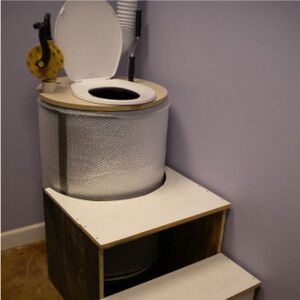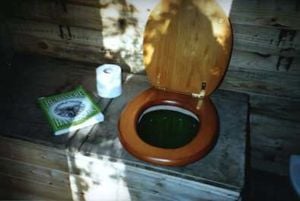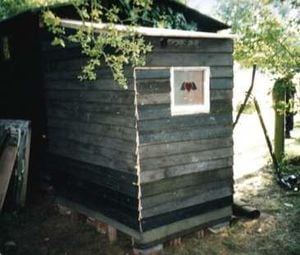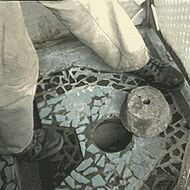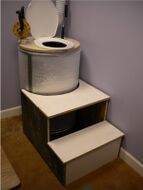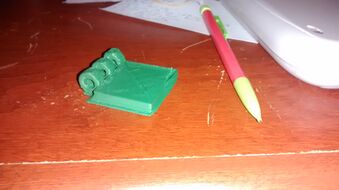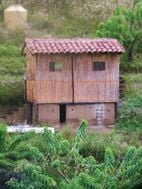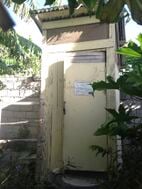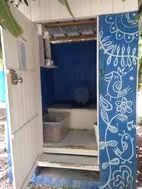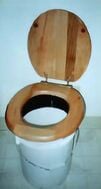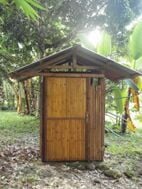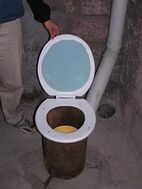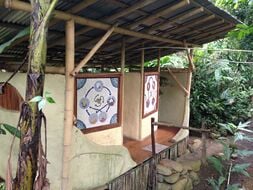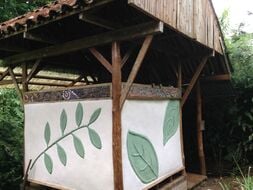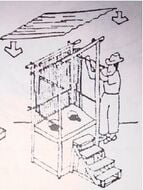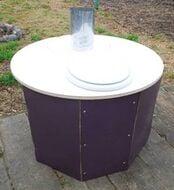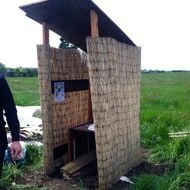퇴비화 화장실은 인간 의 배설물을 인간의 배설물로 처리하고 처리하는 생물학적 과정을 사용합니다 . 사람과 생활공간으로부터 배설물을 제거하여 안전하게 보관 및 처리하여 지역농업에 안전하게 재사용할 수 있도록 하는 시스템입니다 . 이는 일반적으로(항상 그런 것은 아님) 건식 변기 또는 소변 전환 건식 변기인 변기 와 (거의 항상) 종종 변소라고 불리는 일종의 저장 시스템으로 구성됩니다. 이는 주변 환경에 대한 장벽이 없고 물질이 침출되는 구덩이 변소와는 대조적입니다. 해당 분야에서 사용되는 공통 용어를 명확하게 정의하려는 매우 중요한 문서입니다.
이는 노상 배변 보다 지역사회에 더 나은 건강을 제공하고 때로는 단일 구덩이 화장실 과 관련된 문제를 줄이는 것을 목표로 하는 매우 일반적인 WASH 시스템입니다. 누출로 인해 지하수 와 식수 가 질병을 유발하는 유해 미생물에노출될 수 있습니다 .
적절한 기술의 화장실 시스템은 위험도가 높은 활동일 수 있습니다. 감염 위험을 최소화하기 위한 전략은 아래를 참조하세요.
내용물
에코산이란?
생태학적 위생 (EcoSan)은 ( 하수구 및 대규모 도시 폐수 처리 시설을 기반으로 하지 않고) 분산된 위생 시스템을 설명하기 위해 WASH 서클 에서 사용되는 용어로, 사람들이 자신의 폐기물을 잠재적인 자원으로 보도록 장려하는 것을 목표로 합니다. 문제라기보다. [1] 이는 "물을 내리고 잊어버리는" 사고방식이 거의 모든 곳에서 발견되기 때문에 복잡한 하수 시스템을 갖춘 국가에서 폭넓게 적용할 수 있습니다.
Ecosan과 퇴비화 화장실은 종종 같은 의미로 사용되는 용어이며 제대로 정의되지 않을 수 있습니다. 다양한 다른 과정을 포함할 수 있고 포함해야 하는 생태 위생의 일부로 화장실 퇴비화를 고려하는 것이 가장 좋습니다.
그들은 어떻게 작동해야 하나요?
사람의 대변은 특히 유아의 주요 사망 원인인 설사 및 기타 질병을 유발하는 미생물 병원균의 주요 경로입니다 . 병원균은 대변을 체온에 가깝게 유지하면 생존할 수 있지만, 대변이 완전히 건조된 경우에도 여전히 위험할 수 있습니다.
퇴비화 과정은 병원균이 다른 '건강한' 토양 미생물과의 경쟁으로 파괴되는 상황을 조장하는 것을 목표로 합니다 . 이 환경은 탄소가 풍부한 물질을 첨가하고, 수분 수준을 낮추고, 통기를 통해 산소를 증가시킴으로써 생성됩니다.
따라서 퇴비화 화장실은 병원균을 파괴할 수 있는 최상의 조건을 장려하기 위한 낮은 기술 방법이며 일반적으로 배변 후 탄소가 풍부한 물질(보통 재나 톱밥)을 추가하는 것을 포함합니다. 표준 구덩이 화장실을 더 작고, 더 방수되고, 더 나은 공기 공급을 위해 수정하는 경우가 많습니다 (아래 참조). 이는 퇴비화 화장실이 일반적으로 구덩이 화장실보다 더 정기적으로 비워진다는 것을 의미합니다.
전부는 아니지만 많은 시스템에서 소변 은 감염원이 될 가능성이 훨씬 적고 직접적인 형태의 비료로 더 쉽게 사용될 수 있으므로 소변은 대변과 분리됩니다. 일반적으로 퇴비화 과정은 대변이 더 건조해지고 누출 위험이 줄어들 때 더 효율적인 것으로 간주됩니다.
화장실과 변소는 임시 보관을 위해 사용될 수도 있으며, 지역적 2차 처리를 위해 배설물을 제거할 수도 있습니다.
장점
사람의 배설물(가공 또는 생배설물)을 토양에 직접 처리하는 화장실 시스템 (예: 배수장 에 연결된 정화조에 연결된 구덩이 화장실 및 수세식 변기 )은 물에 잠긴 지역과 지하수위가 높은 지역을 오염시킬 수 있습니다. 이로 인해 사람들은 콜레라, 이질, 설사, 황달, 장티푸스, 소아마비 및 장내 기생충에 걸릴 위험이 있습니다.
이전에 만족스러운 위생 시스템이 운영되지 않았던 물에 잠긴 지역에서는 퇴비 화장실이 제공하는 이점이 분명합니다. 이는 지상 및 지표수 오염을 방지하고 지상 또는 수역으로 직접 노상 배변이 일반적인 지역에서 사람들의 건강을 보호할 수 있습니다. 안전한 퇴비를 생산하고 소변과 세척수의 효과적인 사용 또한 중요한 이점입니다.
퇴비화 화장실은 또한 하수 오염으로부터 지표수 와 지하수 를 보호합니다 . 수세식 화장실 과 달리 퇴비화 화장실에서는 처리되지 않은 하수를 생성하지 않으며 냄새도 나지 않습니다. 그들은 엄청난 양의 물을 절약합니다 .
퇴비 화장실을 사용한다는 것은 도시와 도시 주변 지역에서 자본 집약적인 하수 네트워크와 하수 처리장을 확장할 필요가 없다는 것을 의미합니다. 또한, 적어도 이론적으로는 정화조가 없다는 것은 정화조를 비우는 것이 더 안전한 과정이라는 것을 의미합니다. 추가 인프라를 유지하는 데 드는 반복적인 비용도 방지됩니다. 이 두 요소 모두 엄청난 비용 절감 효과를 나타냅니다. 또한, 화장실을 생활용수로 씻어내는 지역에서는 물 요구량을 크게 절약할 수 있습니다.
퇴비 화장실이 표준 위생 기술로 잘 확립된 곳에서는 수도 본관과 하수구 사이의 교차 오염이 근절되거나 근절되어야 합니다. 양질의 퇴비를 정기적으로 첨가하면 토양이 꾸준히 개선됩니다.
이 기술은 또한 구덩이 굴착이 어렵거나 비용이 많이 들거나 부적절한 단단한 암석 토양이 있는 지역에 매우 적합합니다. 퇴비는 가치가 높으며 얇고 부서지기 쉬운 토양에 식물이 덮개를 씌울 수 있는 더 나은 기회를 제공하는 데 도움이 될 수 있습니다.
마지막으로 추가적인 장점은 퇴비화 화장실이 적절하게 건설되면 파리나 냄새가 발생하거나 발생하지 않을 수 있다는 것입니다. 또한 모기의 번식지를 제공하지 않습니다. 정화조와 구덩이 화장실의 덮개는 잘 맞지 않거나 비운 후 덮개를 조심스럽게 교체하지 않는 경우가 많습니다. 이러한 장소는 이론적으로 퇴비화 화장실에는 존재하지 않는 모기의 주요 번식지가 됩니다.
단점
퇴비화 화장실 의 주요 문제 는 이와 관련된 냄새와 병원균 입니다. 악취를 억제하려면 물 없는 변기를 사용할 때마다 톱밥이나 기타 고탄소 물질로 덮개를 씌우는 것이 중요합니다. 이렇게 하면 냄새를 줄이고 물 없는 화장실과 퇴비더미를 위생적으로 유지하는 데 도움이 됩니다. 고탄소 소재와 함께 사용해야 하는 또 다른 방법은 환기입니다. 이는 벽과 지붕 사이의 틈만큼 간단할 수도 있고 전기 환기 팬과 같이 더 복잡할 수도 있습니다.
한 가지 주요 단점은 퇴비를 퇴적시키기 위해 사용자가 수동으로 농경지로 옮겨야 한다는 점이며, 이는 감염의 주요 잠재적 원인입니다.
효율적으로 퇴비화하고 배설물 을 위생 처리 하려면 30°C 이상, 이상적으로는 장기간 동안 50°C 이상의 일정한 온도가 필요합니다. 퇴비화 화장실의 재료는 결코 그 온도에 도달하지 못하거나 재료 내의 일관성이 제한되어 대다수가 있는 곳에서도 적절하게 위생 처리되지 않은 일부가 있을 수 있습니다. 살아남은 미생물이 남은 물질에 다시 접종할 수 있으므로 이는 잠재적인 문제가 될 수 있습니다.
위생의 가장 효율적인 형태는 호기성 조건이지만, 특정 퇴비화 화장실 시스템의 실제 조건은 혐기성 구역과 호기성 구역이 혼합되거나 심지어 대부분 혐기성 구역일 수도 있습니다. 대부분의 미생물 병원체는 혐기성이며 호기성 조건에서 파괴되기 때문에 이는 공정의 효율성과 관련하여 중요한 의미를 갖습니다. 혐기성 소화 시스템은 배설물 처리에 효과적인 것으로 나타났으며 슬러지의 야외 공동 퇴비화는 효과적인 것으로 알려져 있으므로 퇴비화 화장실은 실제로 모든 옵션 중 최악을 나타낼 수 있습니다.
Hill과 Baldwin [2] 은 설득력 있게 다음과 같이 썼습니다.
[퇴비화 화장실]에 관한 제한된 문헌, 특히 현장 대 실험실 연구는 일반적으로 배설물 분해 또는 위생에 대한 신뢰성을 입증하지 못합니다. 적절한 온도에 도달하는 경우는 거의 없으며 병원체 파괴의 신뢰할 수 있는 메커니즘을 제거합니다. 보관만으로는 신뢰할 수 있는 병원체 파괴 메커니즘이 될 수 없습니다.
또한 대부분의 퇴비화 시스템은 6~12개월 동안만 재료를 저장할 수 있습니다. 관리가 부실하거나 예상치 못한 상황으로 인해 화장실을 더 정기적으로 비워야 하며 이는 사용자의 전반적인 병원체 위험에 중요한 결과를 초래할 수 있습니다.
퇴비화 화장실은 안전한가요?
Stenström 등 [3] 은 다양한 WASH 위생 시스템에서 미생물 노출 위험을 평가하려고 했습니다. 그들은 시설의 운영 및 비우기와 관련된 위험이 있다고 결론지었습니다. 화장실이 깨끗하게 유지된다면 건식 변기의 형태는 사용자와 청소부/작업자에게 중간 내지 낮은 감염 위험을 제공했습니다. 그러나 이러한 시스템에서 생성된 물질을 수동으로 처리하는 것은 위험 할 수 있습니다 .
퇴비화 화장실은 병원균을 파괴하여 안전한 퇴비를 생산하도록 설계되었습니다. 그러나 연구에 따르면 다양한 상황에서 병원체가 반드시 파괴되는 것은 아닙니다. 일반적인 배설물의 조언은 퇴비를 최소한 1년 동안은 처리해서는 안 되며, 그때라도 반드시 완전히 위생 처리된 것으로 간주해서는 안 된다는 것입니다. 이상적으로는 변기 구덩이의 모든 퇴비를 농경지에 추가하기 전에 추가 처리를 거쳐야 합니다.
이 주제에 관한 학술 문헌에 대한 자세한 논의를 보려면 Ecosan의 감염 위험을 참조하세요 .
전염병의 유병률이 매우 낮고 의료 서비스가 매우 우수한 국가에서는 이러한 위험이 존재할 수 있지만 개인에게 미치는 영향은 훨씬 낮을 수 있습니다. 그러나 모범 사례에서는 기술이 사용되는 곳마다 감염 위험과 경로를 신중하게 고려하는 것이 좋습니다.
가능한 건강 위험 및 미적 문제
사람의 대변에는 사람의 질병과 관련된 박테리아 및 기타 병원체가 포함될 수 있기 때문에 부적절하거나 불완전하게 퇴비로 만들어진 경우 접촉하면 위험할 수 있습니다. 이러한 이유로, 인간 배설물은 철저하게 퇴비화되지 않고 비료로 사용되어서는 안 됩니다. 웨일즈의 대체 기술 센터 ( CAT)에서는 진정한 호열성 분해가 보장될 수 없는 영국에서 경험한 것과 같은 선선한 온대 기후 에서 인간의 가축이 최소 1년 동안 분해되도록 허용해야 한다고 권장합니다 . 그들은 또한 야채 나 샐러드 잎 과 같이 직접 취급하고 먹는 작물 에 인분을 비료로 사용하지 말고 대신 덤불 이나 나무 열매 주변의 뿌리 덮개 로 적용해야 한다고 조언합니다 . The Humanure Handbook 의 저자이자 인간 질료 퇴비화 의 지지자인 Joseph Jenkins는 모든 농산물에 퇴비화된 인간질료를 사용할 것을 권장합니다.
'선진국'의 많은 사람들은 퇴비화 화장실에 대한 아이디어가 매력적이지 않다고 생각합니다. 아마도 위에서 제기한 건강 및 위생 문제 때문일 것입니다. 그러나 기본 안전 규칙과 상식이 사용되는 한, 퇴비화 화장실 시스템과 관련된 실제 위험은 어느 정도 배설물 오염이 있을 수 있는 다른 상황(예: WC 스타일 화장실 사용, 아기 기저귀 갈기, 목욕하기 등). 퇴비화 화장실의 안전한 사용에 대해 사람들을 교육하는 것은 선진국 사용에 대한 수용을 얻는 데 중요한 부분입니다. 물 기반 변기가 원래 변기를 교체했을 때 동일한 유형의 의심을 받았다는 점도 주목할 가치가 있습니다.
많은 보건부에서는 오수 처리장의 대안으로 퇴비화 화장실을 승인하지 않습니다. 퇴비화 화장실이 승인된 경우에도 오수 처리를 위해 정화조가 필요할 수 있습니다 . 상당한 투자를 하기 전에 지역 보건부에 문의하십시오.
용도에 맞게 적절하게 설계되고 크기가 조정된 퇴비화 화장실은 처리에 전력이 필요하지 않으며 물을 사용하지 않으며 결국 추가된 유기 물질(대변 및 화장지)의 최종 1~2%로 고형물을 줄입니다. 진정한 퇴비화는 느린 과정으로 약 4~6년이 걸리며 박테리아, 곰팡이 , 벌레 및 기타 미생물 및 거대 유기체와 관련된 다양한 과정이 필요합니다 .
생태학적으로 더 복잡한 소규모 시스템의 경우 상황에 따라 전기 사용과 물 사용을 비교 평가해야 할 수도 있습니다. 건조한 지역에서는 물이 전기보다 더 가치가 높지만, 습한 지역에서는 그 반대일 수 있습니다.
커뮤니티 지원 만들기
모든 퇴비화 화장실 프로그램에는 사용 및 유지 관리 원칙을 사용자 그룹이 명확하게 이해하고 수용할 수 있도록 하는 교육 프로그램도 필요하다는 점을 인식하는 것이 중요합니다.
퇴비화 화장실 설치 초기 단계에서 사용자에게 적절한 인식 제고와 교육이 제공되어야 합니다. 화장실은 올바르게 설계 및 제작되어야 하며 도입 시 매우 상호작용적이고 참여적인 접근 방식이 이루어져야 합니다. 이러한 조치를 취하면 퇴비화장실이 지역사회에서 "소유되고, 이해되고, 받아들여질" 가능성이 훨씬 더 커집니다. 이는 성공하는 데 필수적입니다.
대화형 교육과 인식 제고의 필요성은 위생, 건강, 위생, 물 및 환경을 둘러싼 오해와 혼란을 풀고 없애기 위한 것입니다. 예를 들어, 한 프로젝트에서 퇴비 화장실에 대한 주요 관심은 그것이 노상 배변보다 더 안전하고 위생적이기보다는 프라이버시를 제공하는 것이었습니다. 동시에, 이용자와 이웃의 가장 큰 두려움은 냄새가 날 것이라는 점이었습니다. 두려움과 오해를 알면 위생 인식 제고가 특정 지역사회의 필요에 맞게 맞춤화될 수 있습니다.
인식 팀에 대한 교육은 커뮤니티와 동일한 오해를 가질 수 있으므로 매우 신중하고 대화식으로 수행되어야 합니다. 이미 지역사회에서 발전에 적극적이고 지역적으로 좋은 평가를 받고 있는 여성과 청소년들로 팀을 구성하는 것이 도움이 되는 경우가 많습니다. 지역사회에 다가가는 데 효과적인 몇 가지 방법은 질병을 일으키는 다양한 대변-구강 경로를 설명하고 이를 일상적인 사건 및 습관과 연관시키는 거리 드라마 공연입니다. 그림이 포함된 전단지를 배포하고, 학교에서나 여가 시간에 어린이와 성인과 함께 게임을 하고 노래를 부를 수 있습니다. 메시지를 확인하고 드라마와 전단지에 대해 논의하기 위해 가정 방문을 해야 합니다. 사람들은 일반적으로 개인적으로 의심을 더 많이 표현하려는 경향이 있기 때문에 이러한 방문은 특히 효과적일 수 있습니다.
또한 지역사회 자체의 더 나은 위생에 대한 수요를 자극하기 위한 노력인 지역사회 주도의전체 위생을 참조하세요.
이해
퇴비화 화장실은 토양 개량제로 사용할 수 있는 안전한 퇴비를 생산하기 위한 전체 시스템으로 이해되어야 합니다. 따라서 수집 용기(화장실 또는 소변기), 저장 공간(변소, 구덩이 또는 저장 탱크) 및 처리 장치를 포함하도록 시스템의 일부를 고려하는 것이 도움이 될 수 있습니다.
때때로 퇴비화 화장실은 작은 구덩이 화장실 로 묘사되며 종종 소변 전환 건식 화장실이 포함됩니다 . 때때로 단일 VIP 및 이중 VIP 화장실 또는 변형은 미생물 병원균의 유용한 위생이 화장실에서 발생할 것으로 간주되기 때문에 퇴비화 화장실로 간주됩니다.
이러한 변형은 특히 냄새와 파리와 관련하여 도움이 될 수 있지만 화장실의 조건은 이상적이지 않으며 병원균에 미치는 영향은 매우 다양합니다. 따라서 이러한 시스템에서 생성된 모든 물질은 톱밥이나 재가 대변에 추가되어 권장 보관 기간 동안 방치된 경우에도 기껏해야 부분적으로 처리된 것으로 간주해야 합니다.
따라서 중요한 두 가지 유형의 퇴비화 화장실 시스템은 유해한 병원균을 적절하게 파괴하는 시스템과 그렇지 않은 시스템입니다. 화장실이나 변소 내에서 배설물을 완전히 처리하는 것은 일종의 기계적 교반 및 강제 통기 없이는 불가능합니다.
위험을 줄이려면 퇴비화 화장실에서 나오는 물질을 식량 작물에 직접 투입해서는 안됩니다. 최소 1년 동안 변소에 보관하는 것이 좋습니다. 그 후에는 물질을 제거하고(이상적으로는 최소한의 취급으로) 2차 처리를 위해 가져가야 합니다. 가장 간단한 2차 처리 시스템은 지역사회 규모의 공동 퇴비화 또는 지렁이 배양으로, 적절하게 관리하면 위생 처리에 효과적인 것으로 나타났습니다.
이 치료를 받는 동안 작업자는 감염 위험이 높으므로 보호복을 착용해야 합니다. 처리 후에도 잎이나 덩이줄기 등 인간과 직접 접촉하는 모든 식량 작물에 배설물 퇴비를 사용해서는 안 됩니다. 이상적으로는 퇴비를 식용 작물에 전혀 사용해서는 안됩니다.
유형
퇴비 변기에는 두 가지 기본 유형이 있는데, '현장에서' 퇴비화 과정을 완료하는 것과 변기 자체에서 멀리 떨어진 별도의 퇴비 더미로 비워지는 것입니다. 후자의 배열은 Humanure 버킷 시스템 과 같이 구어체로 '버킷 앤 척 잇(bucket and chuck it)' 시스템이라고도 합니다 . 이는 과도한 액체를 흡수하고, 인간의 배설물을 덮고, 파리를 제외하고, 냄새를 줄이고 탄소 : 질소 비율의 균형을 맞추기 위해 짚 , 톱밥 , 마른 풀 등과 같은 물질을 담그는 플라스틱 용기에 배설물을 넣는 것을 의미합니다. . 가득 차면 양동이를 제거하고 부엌이나 정원 쓰레기와 같은 다른 퇴비 재료와 별도로 보관되는 퇴비 더미에 비웁니다.
일부 퇴비화 화장실은 전기를 사용하는 반면 다른 화장실은 전기를 사용하지 않습니다. 일부 전기 시스템은 팬을 사용하여 공기를 배출하고 미생물 활동을 증가시킵니다 . 다른 시스템에서는 사용자가 퇴비화 드럼을 회전시키거나 때때로 퇴비화 인간을 저어주어야 합니다.
일부 퇴비화 화장실은 크기가 크며 변기 아래 공간에 상당한 공간이 필요합니다. 다른 것들은 전통적인 화장실보다 크게 크지 않습니다. 이러한 소규모 시스템은 일반적으로 현장에서 퇴비화를 완료한다고 주장하지 않지만 다른 위치(예: 퇴비 더미)에서 2차 퇴비화를 위해 인간 폐기물을 준비하고 있습니다.
모든 퇴비화 화장실은 결국 일부 최종 제품 제거가 필요합니다. 실제 크기의 퇴비화 변기에서는 활성 탱크 용량이 연간 추가 용량의 최소 3배인 경우 수십 년 동안 고형물을 제거할 필요가 없습니다. 이는 시간이 지남에 따라 볼륨이 급격히 감소하기 때문입니다. 약 5년이 지나면 원래 볼륨의 1~2%만 남게 됩니다. 그러면 더 이상 분해되지 않는 광물화된 토양이 됩니다. [3]을 참조 하세요. 기타 소규모 시스템에서는 1년에 여러 번 고형물을 제거해야 합니다.
상업용 시스템
최근 몇 년 동안 여러 상업용 퇴비 화장실 시스템이 사용량이 많은 공공 시설의 기존 화장실과 경쟁하고 대체하기 시작했습니다. 그곳에서 그들은 탄력성과 오염 물질을 환경에 배출하지 않는 환경적 이점 때문에 시장을 찾았습니다 . 퇴비화 화장실은 주로 중온성 퇴비화를 통해 수개월 또는 수년에 걸쳐 현장의 인분 및 기타 유기 물질의 양을 줄이고 법적으로 요구되는 기간이 지나면 원예 또는 농업 분야에 활용될 수 있는 비료를 생산합니다. 퇴비화 화장실은 또한 가정에서 대안으로 점점 더 보편화되고 있습니다. 제대로 작동하는 장치의 냄새 없는 작동은 많은 양의 깨끗한 물을 소비하는 기존 화장실보다 일부 주택 소유자에게 더 매력적입니다.
퇴비화 화장실은 국제적으로 인정받는 NSF( 모든 유형의 물 및 위생 제품에 대한 테스트 시설)의 테스트를 거쳐 승인되면 라벨을 부착함으로써 주류 배관 영역에 진입했습니다. 퇴비화 화장실에는 Standard-41이라는 자체 테스트 표준이 있습니다. Standard-41은 CSA 또는 UL 과 같은 다른 공인 테스트 연구소에서도 테스트를 거쳐 인증을 받을 수 있습니다 .
물과 냄새가 없는 퇴비화 화장실은 가뭄 지역에서 일정 기간 물이 차단되는 곳에서도 집이 계속 거주할 수 있도록 보장합니다. 예를 들어 스페인 남부에서는 가뭄이 계속되고 물을 사용할 수 없는 동안 집당 최소한 하나의 퇴비화 화장실이 허용 가능한 위생을 제공할 수 있습니다. 마찬가지로 이러한 상황에서도 항상 사용할 수 있는 공중화장실 시설을 제공합니다. 이는 주기적으로 물을 이용할 수 있는 전 세계 지역에서 이 기술을 적용하는 데 매우 중요한 역할을 하고 있습니다.
'DIY' 퇴비 화장실 시스템
여러 가지 중요한 요소에 주의를 기울인다면 비용이나 유지 관리가 거의 필요하지 않은 훨씬 더 간단하고 기본적인 DIY 시스템을 구축할 수도 있습니다. 화장실에서는 냄새를 제어해야 합니다. 이는 적절한 환기를 보장함으로써 달성됩니다(때로는 단순히 벽 상단과 지붕 사이에 작은 간격을 두는 것만으로도 더 정교한 시스템에는 일종의 저전압 추출 팬이 통합될 수 있습니다). 소변 과 대변을 분리하여 보관 하거나 과도한 액체를 흡수할 수 있을 만큼 탄소 함량이 높은 '담그는' 물질(아래 참조)을 추가하여 냄새를 조절할 수도 있습니다 . 퇴비화 변기의 디자인은 퇴비가 불쾌한 냄새를 유발할 수 있는 혐기성 상태가 되는 것을 방지하기 위해 물질에 공기가 공급된 상태를 유지하도록 해야 합니다. 또한 병원체가 파괴될 정도로 대변을 가열하거나 (호 열성 과정), 그러한 병원체가 분해되어 자연적으로 사라질 때까지 충분한 시간(최대 1년)을 허용해야 합니다(중온 성 과정). 그러나 좋은 점은 상당한 양의 물을 사용하지 않으며 소규모 농업용 으로 안전한 비료를 생산할 수 있다는 것입니다 .
또 다른 변형은 비울 필요가 없는 일종의 퇴비 화장실인 나무 습지 입니다. 빠르게 자라는 버드나무와 같은 영양이 부족한 나무 는 나무 늪지 주변에 심어져 영양분을 흡수하여 이를 바이오매스 로 변환하여 수확할 수 있습니다.
건식 화장실
건식변기는 물 없이 작동하는 변기를 말한다. 건식 변기는 사용자가 앉을 수 있는 높은 받침대일 수도 있고, 사용자가 쪼그려 앉는 스쿼트 팬일 수도 있습니다. 두 경우 모두 배설물(소변과 대변 모두)이 물방울 구멍을 통해 떨어집니다.
여기서 건식변기란 구체적으로 사용자가 앉거나 쪼그려 앉는 장치를 말합니다. 다른 문헌에서 건식 화장실은 다양한 기술 또는 기술의 조합(특히 구덩이)을 의미할 수 있습니다.
건식 변기는 일반적으로 구덩이 위에 배치됩니다. 두 개의 구덩이를 사용하는 경우 받침대나 슬래브는 한 구덩이에서 다른 구덩이로 들어 올려 이동할 수 있도록 설계해야 합니다.
슬래브 또는 받침대는 사용자에게 안전하고 빗물이 구덩이에 침투하는 것을 방지할 수 있도록 구덩이에 적합한 크기여야 합니다(넘칠 수 있음).
퇴비화와 비료화는 유기농법과 정원 에 있어 중요한 단계입니다 . 필요한 질소 수준을 얻으려면 물이 없는 변기를 사용하고 제품을 퇴비 더미에 추가할 수 있습니다.
| 장점 | 단점 |
|---|---|
- 지속적인 물공급이 필요하지 않습니다.
| - 냄새는 일반적으로 눈에 띕니다(배설물을 수집하는 데 사용되는 금고나 구덩이에 배기 파이프가 장착되어 있는 경우에도 마찬가지).
|
퇴비화 공정 및 제품
인간의 배설물을 안전하고 사용 가능한 퇴비로 전환하는 과정은 기후 , 온도 및 사용되는 특정 시스템과 같은 요인에 따라 3개월에서 몇 년이 걸릴 수 있습니다. 그리고 4~6년 안에 고도로 광물화된 토양이 될 것입니다. 일부 퇴비화 변기 모델은 동시에 소변 을 무취, 무 병원체 유기 액체 비료 로 전환시킵니다 . 스웨덴 과 같은 일부 국가에서는 6개월의 보관 기간 후에 이 액체를 농업 에 사용하는 것을 허용합니다 . 전체 크기의 퇴비화 화장실에서 소변은 질산화라는 과정을 거쳐 냄새가 없고 사실상 박테리아가 없는 액체 비료가 됩니다.
대변보다는 소변에는 질소의 90%와 인의 70%를 포함하여 재사용을 위해 회수할 가치가 있는 주요 식물 영양소가 포함되어 있습니다. 기존 옥외 변소에 비해 현대식 퇴비화 화장실의 한 가지 장점은 후자가 대부분의 영양분을 농업에 재사용하거나 토지에 퍼뜨리기 위해 저장하는 대신 지하수로 침출한다는것 입니다.
Appropedia에서 사례 연구 및 방법을 확인할 수 있습니다.
Ole Ersson의 톱밥 변기 사용법 은 간단한 수집 시스템을 만드는 방법과 톱밥을 이용한 외부 퇴비화 방법을 설명합니다.
Pedregal Permaculture Demonstration Center에서는 소변 전환 이중 구덩이 퇴비화 변기의 형태와 기능을 설명합니다.
New Dawn 퇴비화 화장실 사용법 은 코스타리카 약초학 학교가 단일 구덩이 퇴비화 화장실을 어떻게 구성하고 운영하는지 설명합니다.
Noyemberyan 퇴비화 화장실 페이지에는 아르메니아 평화 봉사단이 설치한 시스템에 대한 정보가 많지 않지만 단일 환기 개선 구덩이 디자인의 형태를 보여주는 좋은 사진이 몇 장 있습니다.
Cal Poly Humboldt의 CCATBox 는 단일 통풍 구덩이 화장실의 형태이지만 강제 공기가 이를 통해 펌핑되고 회전 드럼이 있어 퇴비의 혼합 및 위생이 보장됩니다.
Duchamp de Loo는 바지선에서 사용할 이동식 화장실을 만든 Humboldt State의 또 다른 학생 프로젝트입니다. 이는 퇴비화 를 위해 다른 곳으로 이동되는 소변 전환 및 배설물 수집 시스템으로 구성됩니다 .
고려해야 할 대안
관련 프로젝트
Notes and references
- ↑ important document that attempts to define clearly common terms used in the sector
- ↑ Hill, G. B., & Baldwin, S. A. (2012). Vermicomposting toilets, an alternative to latrine style microbial composting toilets, prove far superior in mass reduction, pathogen destruction, compost quality, and operational cost. Waste Management.
- ↑ Stenström TA, Seidu R, Ekane N, and Zurbrügg C. Microbial Exposure and Health Assessments in Sanitation Technologies and Systems (2011). EcoSanRes
Further reading
- Fertile Waste: Managing your domestic sewage, Peter Harper, 1994, Centre for Alternative Technology (CAT), Machynlleth, Powys, SY20 9AZ, United Kingdom. Tel: +44 (0)1654 702400 Fax: +44 (0) 1654 703605. ISBN 1 89804 902 5 GBP£4.50
- Lifting the Lid: Ecological approach to toilet systems, Peter Harper with Louise Halestrap, CAT (address as above) ISBN 1 89804 979 3 GBP£10
- Low-cost Sanitation; A survey of practical experience, J. Pickford, 1995, IT Publications, 103/105 Southampton Row, London, WC1 4HH, United Kingdom. ISBN 1 85339 233 2
- Environmental Sanitation Revised and Enlarged Edition, P. Calvert et al 2004 SIDA. Sweden.
- Ecological Sanitation in India and Sri Lanka, Paul Calvert, Please visit http://www.ecosanres.org/ for more information.
- Ecological Solutions to Flush Toilet Failures ISBN 0-9547873-0-7 at http://www.eco-solutions.org/books.html
- Toilets that make Compost - low-cost sanitary toilets that produce valuable compost for an African Context by Peter Morgan 2007 SIDA Sweden
See also
- Category:Composting toilets
- Appropriate technology#Water and sanitation
- Biogas: anaerobic digestion of manure and waste plant parts generates biogas
- Wastewater
- Composting human feces
- Greywater
- Constructed wetlands
- Integrated compost heater toilet
- Humanure for soil building project
- Integrated compost heater toilet
External links
- Wikipedia:Composting toilet
- Wikipedia:Latrine
- Wikipedia:BiPu (emergency latrine)
- Wikia:Permaculture:Composting toilets
- Composting toilet FAQ, Composting Toilet World website, sponsored by Envirolet (Sancor).
- City Farmer on composting toilets
- RILES: A U.S. organization working on issues related to sustainable sanitation
- A photo essay on the construction of a 'DIY' compost toilet
- podcast by Paul Wheaton and Jocelyn Campbell on food matters discusses composting toilets between minutes 34-51
- Toilet alternatives forumsat Permies.com
- RILES: A U.S. organization working on issues related to sustainable sanitation
- City Farmer Page
- www.poohsolutions.com
- Compost toilet building workshop in Essex, England
- A photo essay on the construction of a 'DIY' compost toilet
- 'The Humanure Handbook'
- Composting Toilet World
- BioLet Composting Toilets
- Sun-Mar Composting Toilets
- Envirolet Composting Toilets
- Nature's Head Composting Toilets
